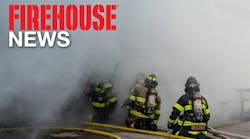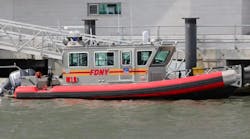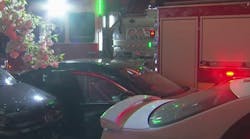NEW YORK CITY: JAN 1, 1910 — Just as the clock struck midnight and the New Year began, a voice rose from the crowd gathered at 26th Street and Broadway in Manhattan: "Look! Look there!" All eyes went to a tongue of flames that climbed the lace curtains in a third-floor-apartment window. As the celebratory moment drew near, partygoers lit several small indoor fireworks displays that showered fountains of sparks like a waterfall. One stray spark had dropped among the lace curtains, igniting them. Within seconds, the flames spread to the evening gown of a woman and in an instant she too was enveloped in fire. A man wrapped his coat around the blazing woman as waiters rushed in with fire extinguishers. Together they doused the flames and rushed the badly burned woman to the hospital.
SCHENECTADY, NY: JAN. 1, 1910 — Just after 1 A.M., flames broke out in the Old South College section of Union College. The college's church bells sounded the alarm and students and staff members evacuated the building. The entire fire department responded to the blazing building and struggled to stop the advancing flames. During the initial attack on the fire, a servant girl became visible at a top-floor window, trapped by the flames. Firemen raced an extension ladder into position and she was pulled from her room in the nick of time. Firemen protected several exposed buildings, including the chapel and a dormitory.
ALEXANDRIA, EGYPT: JAN. 1, 1910 — Assisted by 200 sailors from the German cruiser Freya, local firemen battled a stubborn fire in the customs tobacco stores. Struggling against low water pressure and thick smoke, they saved a significant portion of the huge warehouse. Damage to the stored tobacco was estimated at $1.5 million.
MILWAUKEE, WI: JAN. 3, 1910 — A fire in the local plant of the American Bridge Building Co. at 17th Street and Saint Paul's Avenue took the lives of four Milwaukee firefighters when a wall collapsed, burying them and a number of other firemen beneath the rubble. The men killed were Captain John Hennessey, Lieutenant Dominick O'Donnell, Fireman William Foley and Fireman Joseph Sullivan. Other firemen suffered injuries, including frostbite rescuing the trapped men and extinguishing the fire.
ATHENS, GREECE: JAN. 6, 1910 — While members of the royal family were gathered around their Christmas tree, flames swept the floor above them in the Tatoi Royal Palace, nine miles north of Athens. The family made a hasty exit without injuries. A large force of firemen was soon on the grounds and, assisted by sailors from several visiting ships, removed many valuables and relics and extinguished the fire. The cause of the blaze was believed to have been defective electrical wiring.
BURLINGTON, VT: JAN. 8, 1910 — Two hundred guests were driven from the Hotel Burlington by a late-day fire that destroyed the hotel and spread to the adjacent Walker block. All the guests escaped without injury, but many lost all or some of their belongings. A defective light in a bathroom was the apparent cause of the destructive blaze. Losses were estimated at $300,000.
BROOKLYN, NY: JAN. 9, 1910 — Flames broke out in the Williamsburg Auto Storage Co. garage on Clymer Street during the night. The garage was directly across the street from the quarters of Engine Company 111 (now 211). When members became aware of the blaze, they immediately ran into the building to remove six barrels of gasoline and six taxicabs they knew to be stored inside. They then began an aggressive interior attack of the blazing structure. With the transmission of two additional alarms, they halted the spreading flames from extending to a nearby church.
LONDON, ENGLAND: JAN. 13, 1910 — It was an early closing day and only a few clerks were at work when a fire broke out in the Evan's & Co. dry goods store on the high road to Kilburn, a London suburb. Four of the 11 large shops comprising the establishment were destroyed. Members of the fire brigade stopped the spreading fire before even more damage could be done. Damage was estimated at $500,000.
TRENTON, NJ: JAN. 13, 1910 — The coolness of a Trenton Theatre employee prevented a possible catastrophe when he discovered a fire burning in the cellar beneath a full house of more than 2,000 people watching a vaudeville show. James Clancy took the stage during the last act and calmly told the crowd there was a problem with the lights and that they would have to be shut off in several minutes, and then asked everyone to leave the hall. As they were calmly exiting the theater, a young boy became aware of the smoky fire and dashed toward the exiting throng ready to scream "Fire!" Before he could get close enough an usher grabbed him and hurled him in the opposite direction. The crowd evacuated and firemen quickly extinguished the fire.
CONSTANTINOPLE (now ISTANBUL), TURKEY: JAN. 19, 1910:— The Ciragan Palace, the meeting place of the Turkish Parliament, was destroyed by a fire that started shortly before noon. The elaborate palace, built by Sultan Abdulaziz, was completed in 1867 with inner walls and the roof made of wood and the outer walls of colorful marble. The palace is connected by a marble bridge to the Yildiz (Sun) Palace on the hill behind. A high garden wall protects the palace from the outer world. The fire, started by a defective heating unit between the sultan's private apartments and the Chamber of Deputies area, was fanned by strong winds and was soon out of control. Little was saved and the damage to the building alone was estimated at $16 million.
PHILADELPHIA, PA: JAN. 19, 1910 — A fire originating in an elevator motor trapped men and women working in a factory on the fourth floor at 210 Chancellor St. near Walnut Street. The flames drove the people working on the top floor, a shirtwaist firm, to the windows, where they screamed for help. Before fire units could arrive, the hysterical people began jumping. Men on the street below scrambled to find blankets and attempted to catch the jumpers. In all, four women and one man died from their leaps and four others were in critical condition with injuries and burns.
PAUL HASHAGEN, a Firehouse® contributing editor, is a retired FDNY firefighter who was assigned to Rescue Company 1 in Manhattan. He is also an ex-chief of the Freeport, NY, Fire Department. Hashagen is the author of FDNY 1865–2000: Millennium Book, a history of the New York City Fire Department, and other fire service history books.





